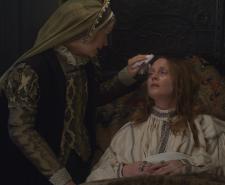
What's coming up on 'Royal Autopsy' series two
Here's everything you need to know about the new series of 'Royal Autopsy'. Presented by Professor Alice Roberts, this unique show investigates the deaths of four British monarch by conducting simulation autopsies on prosthetic bodies.
Image: Dr Brett Lockyer (L) and Professor Alice Roberts (R) | Royal Autopsy
Royal Autopsy is returning to Sky HISTORY for a second series hosted by Professor Alice Roberts. The new four-part series follows on from the success of the first two-parter which explored the deaths of Queen Elizabeth I and King Charles II, and is available to watch on demand now.
The latest edition of Royal Autopsy sees anatomist and biological anthropologist Professor Alice Roberts rejoin Home Office Pathologist Dr Brent Lockyer to lead a unique investigation into the cause of death of four more British monarchs.
These include George IV, who became one of the country’s most obese and ridiculed monarchs, Mary Tudor, who died childless after experiencing phantom pregnancies, Henry IV, who suffered a mysterious skin condition during the later years of his reign, and Queen Anne, who endured no fewer than 17 pregnancies.
Through state-of-the-art reconstruction based on contemporaneous medical records, each episode sees Professor Alice Roberts and Dr Brent Lockyer conduct autopsy simulations on each of the monarchs. This is done using a blend of prosthetic bodies, actors, toxicology testing and forensic analysis.
Their findings, together with Professor Roberts’ interpretation of historical eyewitness accounts, uncover the secrets and explore the theories surrounding the final days of these kings and queens.
Speaking about the show, Professor Alice Roberts said: ‘I’m beyond thrilled that Royal Autopsy is back for a second series and four new investigations. It’s such a unique historical approach to examine, not just the key events of a monarch’s reign, but actually how they lived and suffered as mere mortals. I’m very proud to be a part of it.’
Both series of Royal Autopsy are available on demand to Sky and Virgin customers, as well as streaming now on HISTORY Play.
Royal Autopsy S2: Episode Guide
Episode One – King George IV
Professor Alice Roberts explores possible reasons for the death of George IV, known for a life full of drink, drugs and debauchery. Working with Dr Brett Lockyer, Alice is challenged to see which of his many ailments actually killed him. She takes her findings to leading medical and historical experts for analysis, exploring the cause and symptoms of a wide range of conditions brought on by a life of outrageous excess.
Episode Two – Mary Tudor
Professor Alice Roberts explores the final dying days and ultimate cause of death of Queen Mary I, AKA Bloody Mary. Working with Dr Brett Lockyer, Alice discovers a woman plagued by a range of gynaecological issues, but whose death was eventually down to an illness not too dissimilar to our recent pandemic.
Episode Three – King Henry IV
Professor Alice Roberts investigates the possible ultimate cause of death of England’s Usurper King, Henry IV. The autopsy reveals a man who suffered from a debilitating skin condition, but his eventual cause of death runs much more than skin deep. Working with Dr Brett Lockyer, Alice takes her findings to leading medical and historical experts for detailed analysis. They explore the cause and symptoms of a wide range of diseases, and how each ailment would have affected the King, both in life and eventual death.
Episode Four – Queen Anne
Professor Alice Roberts investigates the life and events leading up to the death of Queen Anne, Britain’s forgotten queen. Working with Dr Brett Lockyer, Alice reveals a woman who suffered heavily with obstetric issues. She takes her findings to leading medical and historical experts for further detailed analysis, exploring the root cause of her many miscarriages and stillbirths, alongside her significant joint pains and mobility problems.
















